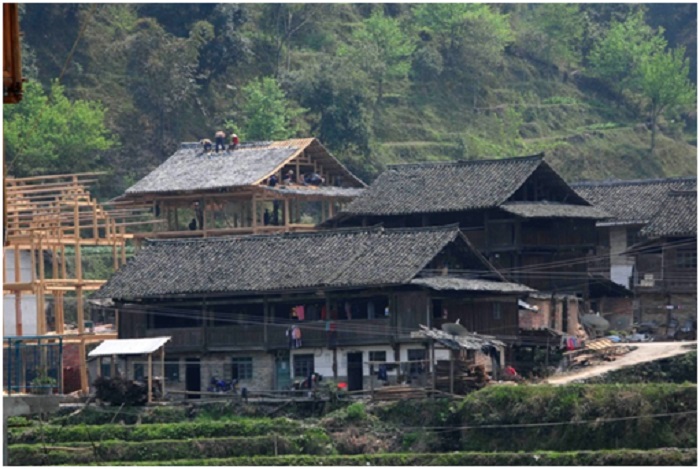



“I only have two dreams all my life and they both came true last year. First, my family moved from a dilapidated wooden house to one made of cement. And then my 36-year-old son got married,” said Luo Huiming, a 63-year-old resident in southwest China’s Guizhou province.
“I finally have a decent house to live in,” added the villager from Daqiao village, Guanling Buyi and Miao autonomous county, Guizhou province.
In fact, nearly 10 million rural residents in Guizhou like Luo have been able to live in decent houses thanks to the efforts of the local government.
As one of the pioneers in China that piloted renovation of run-down houses in rural areas, Guizhou province launched the renovation program in 2008.
Since 2012, the province has renovated dilapidated houses for 2.2 million poor rural households, benefiting over 8 million villagers.
“My old house was built with wood and tiles in the 1980s. I had always been afraid that it would leak and fall down in the rain and heavy winds,” said Zhang Huajun, a villager from Pingshang village, Ziyun Miao and Buyi autonomous county.
Zhang’s house was graded as D-level decrepit house, which means the villager was eligible to receive a subsidy from the government for renovating his house.
However, Zhang has been in bed all year round because of illness and couldn’t possibly improve his house by himself.
To help poor residents like Zhang who lacked funds and capabilities to renovate their houses, the local government established a resettlement site last year, and helped 13 poor households in the village relocate to the new houses at the site.
With the help of the government, a 68-year-old resident surnamed Tao in Pingshang village, saw great improvement to his old house.
In 2019, Tao’s old house was appraised as basically safe, yet the house was troubled by leaking roof as well as decaying doors and windows.
A construction team sent by the government repaired his house for over 10 days and greatly improved his living conditions, according to Tao.
As most of the houses in the rural areas of Guizhou were built with wood and have weathered through the years, the province launched a special program in 2018 to renovate old houses that were in poor condition.
By the end of November 2019, Guizhou had improved the condition of all 306,000 dilapidated houses across the province under the program.
While renovating dilapidated houses in rural areas, the province has also renovated and transformed kitchens, bathrooms, and pens in rural households, and separated kitchens and bedrooms, bathrooms and pens, as well as the living areas of humans and livestock, thus ensuring the sanitary conditions of rural houses and improving the living environment for rural residents.
As poor households that need renovation are mostly located deep in the mountains and relatively isolated from the outside world, Guizhou province has developed and built a monitoring platform for the construction of digital villages as well as an app of the platform to better track renovation efforts, pointed out Huang Hua, deputy head of the housing and urban-rural development bureau at Ziyun Miao and Buyi autonomous county.
A list of poor households provided by relevant poverty alleviation department can be imported into the platform. When front-line officials check the renovated houses on site, they could upload pictures of the houses and relevant information such as house safety assessment results to the platform via their mobile phones, making renovation-related information more accessible and greatly improving efficiency in renovation.
“The platform has made it easier for staff workers to carry out their work outside the office and monitor the renovation process in a real-time manner,” Huang said.
The app has collected key information about the province’s households with run-down houses in details, which could provide comprehensive guidance for front-line officials.
By referring to the app and conducting on-site inspection, they could grasp more complete and accurate information about poor households.
So far, the monitoring platform has covered the whole province.
Since February 2020, 66,142 administrative workers at various levels across Guizhou province have checked information about poor households via the platform for 3,501,649 times, effectively guaranteeing targeted management of rural housing in the province.


The Humanitarian Service Diamond Awards has.
A Chinese Company, Inner Galaxy Steel.


The Programme Coordinator, Regulatory, Compliance and.


A Non-Governmental Organization (NGO), Committee for.
The Trustfund Pensions Limited has chided.


The House of Representatives Committee on.
The China General Chamber of Commerce.


Senator Chuka Utazi who represented Enugu.


An Abuja based Legal Practitioner, Ugochukwu.


The African business community in Yiwu,.
Leave a Comment